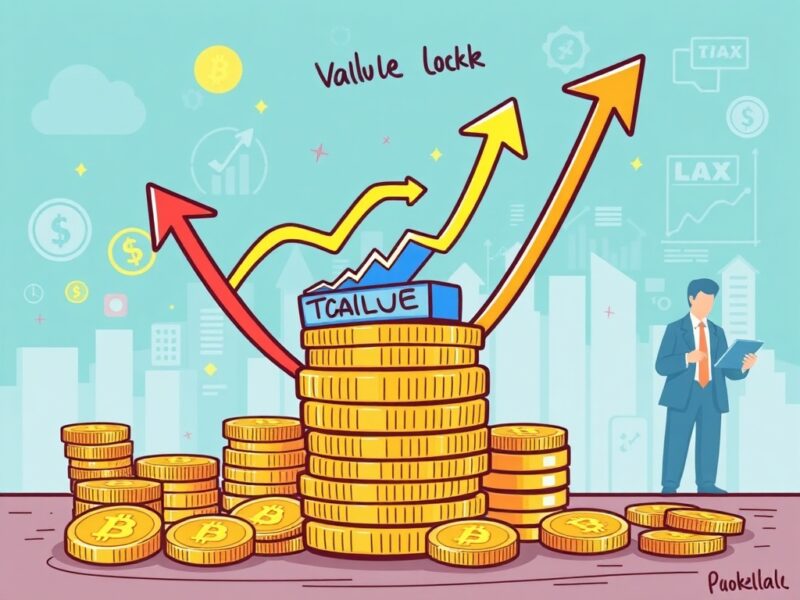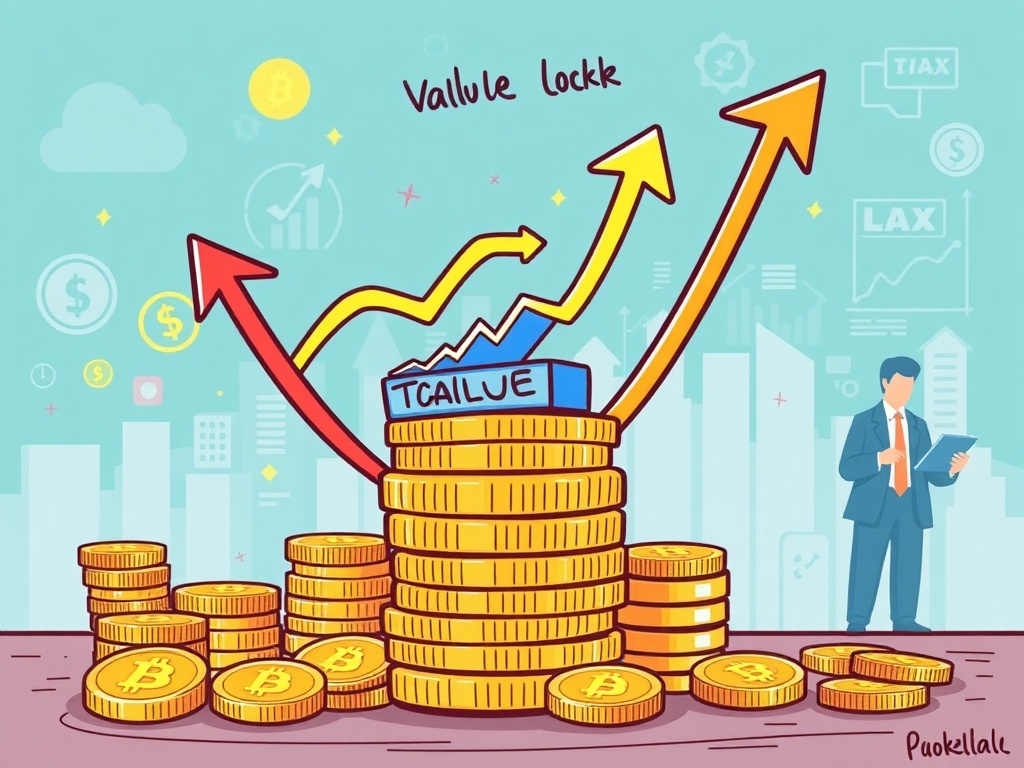DeFi Lending Protocols: Explosive 72% TVL Growth Reshaping Finance
0
0

BitcoinWorld

DeFi Lending Protocols: Explosive 72% TVL Growth Reshaping Finance
Have you been following the remarkable shifts in the world of decentralized finance? The landscape of DeFi lending protocols is experiencing an unprecedented boom, drawing significant attention from both individual and institutional investors. This sector, a cornerstone of the broader DeFi ecosystem, is not just growing; it’s undergoing an explosive transformation.
What’s Fueling the Phenomenal Rise of DeFi Lending Protocols?
The total value locked (TVL) in DeFi lending protocols has reached an impressive milestone, surpassing $127 billion. This figure represents a staggering 72% increase from the $53 billion recorded at the beginning of the year. This substantial surge highlights increasing confidence and capital flow into decentralized lending platforms.
According to a report by Cointelegraph, citing Binance Research, this rapid expansion isn’t accidental. It’s a clear indicator of evolving market dynamics and growing acceptance. The research points to specific catalysts driving this incredible growth, reshaping how we perceive digital finance.
How Are Institutions Driving DeFi Lending Protocols Forward?
A primary driver behind this impressive TVL growth is the active adoption of stablecoins and tokenized assets by institutional investors. These sophisticated market participants recognize the value proposition offered by DeFi lending protocols.
Stablecoins, digital currencies pegged to a stable asset like the US dollar, offer a bridge between traditional finance and crypto, minimizing volatility. Tokenized assets, representing real-world assets on a blockchain, provide new avenues for liquidity and investment. Institutions leverage these tools for yield generation, efficient capital deployment, and enhanced transparency.
Their involvement brings substantial capital and legitimacy to the space, pushing DeFi lending protocols into the mainstream. This institutional embrace is a game-changer, signifying a maturing market and expanding opportunities for all participants.
Who Are the Standout Stars Among DeFi Lending Protocols?
While the entire sector of DeFi lending protocols is flourishing, certain platforms have emerged as frontrunners, demonstrating truly exceptional growth. Maple Finance and Euler stand out as key innovators and market leaders, spearheading much of this expansion.
Maple Finance, known for its institutional-grade lending solutions, saw its TVL grow by an astounding 586%. Euler, another prominent protocol, experienced an even more dramatic increase, with its TVL skyrocketing by 1,466%. These figures reflect successful strategies, robust technology, and strong market demand for their specific offerings.
Their success stories illustrate the diverse approaches and innovative solutions being developed within the DeFi lending space, catering to a wide range of financial needs and preferences.
What Are the Opportunities and Challenges for DeFi Lending Protocols?
The rise of DeFi lending protocols presents both immense opportunities and notable challenges. Understanding these aspects is crucial for anyone looking to engage with this dynamic sector.
Benefits:
- Increased Accessibility: DeFi platforms offer financial services to anyone with an internet connection, bypassing traditional intermediaries.
- Higher Yields: Often, DeFi lending can provide more attractive returns compared to traditional savings accounts.
- Transparency: All transactions on public blockchains are immutable and verifiable, fostering trust.
- Innovation: The sector constantly evolves, introducing new financial products and services.
Challenges:
- Regulatory Uncertainty: The evolving regulatory landscape poses risks for protocols and users alike.
- Smart Contract Risks: Vulnerabilities in code can lead to significant financial losses.
- Market Volatility: The inherent volatility of cryptocurrencies can impact collateral values and loan stability.
- Security Concerns: Exploits and hacks remain a persistent threat in the crypto space.
Therefore, while potential rewards are high, careful due diligence and a clear understanding of associated risks are paramount for participants.
The remarkable expansion of DeFi lending protocols, marked by a 72% TVL surge and significant institutional adoption, signals a pivotal moment for decentralized finance. Leaders like Maple Finance and Euler are demonstrating the immense potential of this sector to innovate and grow. As the ecosystem matures, addressing challenges such as regulation and security will be vital to sustaining this momentum and further integrating DeFi into the global financial fabric. The future of lending looks increasingly decentralized and promising.
Frequently Asked Questions (FAQs)
Q1: What does TVL stand for in DeFi?
A1: TVL stands for Total Value Locked. It represents the total amount of assets currently staked or locked within a decentralized finance (DeFi) protocol. It is a key metric for gauging the overall health and growth of the DeFi ecosystem.
Q2: Why are institutional investors adopting stablecoins and tokenized assets?
A2: Institutional investors are drawn to stablecoins for their stability, making them ideal for large transactions without exposure to crypto volatility. Tokenized assets offer enhanced liquidity, fractional ownership, and transparent settlement, opening up new investment opportunities and efficiencies.
Q3: What are the main risks associated with DeFi lending protocols?
A3: Key risks include smart contract vulnerabilities (bugs in the code), regulatory uncertainty (changing legal frameworks), market volatility (fluctuations in asset prices affecting collateral), and potential for exploits or hacks.
Q4: How do DeFi lending protocols differ from traditional lending?
A4: DeFi lending protocols are decentralized, meaning they operate without intermediaries like banks. Loans are facilitated by smart contracts on a blockchain, offering greater transparency, accessibility, and often higher yields, but also carrying different types of risks compared to traditional finance.
Q5: Can individual investors participate in DeFi lending protocols?
A5: Yes, absolutely! DeFi lending protocols are designed to be permissionless and accessible to anyone with a crypto wallet and internet connection. Individuals can lend their digital assets to earn interest, although understanding the risks involved is crucial.
Enjoyed this insight into the dynamic world of DeFi lending protocols? Share this article with your network and spark a conversation about the future of decentralized finance! Your engagement helps us bring more valuable content to light.
To learn more about the latest crypto market trends, explore our article on key developments shaping Ethereum price action.
This post DeFi Lending Protocols: Explosive 72% TVL Growth Reshaping Finance first appeared on BitcoinWorld and is written by Editorial Team
0
0
 Manage all your crypto, NFT and DeFi from one place
Manage all your crypto, NFT and DeFi from one placeSecurely connect the portfolio you’re using to start.




